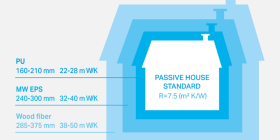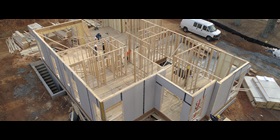
Polyurethane foam insulation couples design freedom with energy efficiency
Versatile material that solves multiple dilemmas
Architects are already acutely aware that 40% of global energy consumption comes from buildings, which also emit more than a third of greenhouse gases. Rigid polyurethane (PUR/PU) and polyisocyanurate (PIR) foams are an interesting choice for architects who are striving to reduce both emissions and energy use, while also enabling them to cope with client design whims, stringent fire and safety regulations, and cost and logistical pressures on the building site.
Thinner thermal protection for wider design flexibility
Rigid foam suits many types of construction
Sealing the building envelope with rigid foam retrofitting
Lower impact on health, enhanced sustainability
Low-emission rigid foam insulation contributes to a healthier indoor environment, reducing moisture and resisting mold formation. The high level of thermal protection means interiors can be easily heated or cooled for optimal comfort. Over its lifecycle, PUR/PIR insulation saves an estimated 70 times more energy than was used to manufacture it.
“Architects don’t have it easy, having to balance many conflicting demands. Rigid polyurethane foam insulation offers better thermal performance than conventional glass wool, stone wool or polystyrene. It also reduces wall, ceiling and floor thickness, opening up a range of design possibilities while also meeting increasingly strict fire protection standards.”
Key Benefits
- Design versatility Thin, durable and space-saving rigid foam opens up new design possibilities.
- Thermal performance Polyurethane foam insulates 30-50% better than mineral wool or polystyrene.
- Tough and durable Rigid foam is low-maintenance and chemical-, weather- and UV-resistant.
- Easy to install PUR/PIR Foam boards can be cut on site, fitting any shape quickly and easily.
- Enhanced sustainability PUR/PIR insulation saves 70 times more energy than was used to manufacture it.
- Flame retardant Dense cross-linked PUR/PIR foams perform well in fire tests & meet safety requirements.







.jpg?h=297&w=594&rev=ee8e09106bd14140b4f8ca39945b151e&hash=9D43F4A5BCF50BCE37ACB3CB5EAF07D9&usecustomfunctions=1¢ercrop=1)





